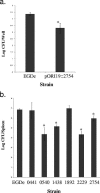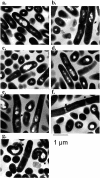Contribution of penicillin-binding protein homologs to antibiotic resistance, cell morphology, and virulence of Listeria monocytogenes EGDe
- PMID: 16870778
- PMCID: PMC1538649
- DOI: 10.1128/AAC.00167-06
Contribution of penicillin-binding protein homologs to antibiotic resistance, cell morphology, and virulence of Listeria monocytogenes EGDe
Abstract
Seven open reading frames, annotated as potential penicillin-binding-protein-encoding genes (lmo0441, lmo0540, lmo1438, lmo1892, lmo2039, lmo2229, and lmo2754), were targeted for insertional mutagenesis in Listeria monocytogenes EGDe. These genes were found to contribute in various degrees to beta-lactam resistance, cell morphology, or the virulence potential of this organism.
Figures


Similar articles
-
Penicillin-binding protein encoded by pbp4 is involved in mediating copper stress in Listeria monocytogenes.FEMS Microbiol Lett. 2017 Nov 1;364(20). doi: 10.1093/femsle/fnx207. FEMS Microbiol Lett. 2017. PMID: 29029084
-
FbpA, a novel multifunctional Listeria monocytogenes virulence factor.Mol Microbiol. 2004 Jul;53(2):639-49. doi: 10.1111/j.1365-2958.2004.04138.x. Mol Microbiol. 2004. PMID: 15228540
-
Characterization of the bifunctional glycosyltransferase/acyltransferase penicillin-binding protein 4 of Listeria monocytogenes.J Bacteriol. 2006 Mar;188(5):1875-81. doi: 10.1128/JB.188.5.1875-1881.2006. J Bacteriol. 2006. PMID: 16484198 Free PMC article.
-
[Contribution of sigma B to environmental stress tolerance in Listeria monocytogenes--a review].Wei Sheng Wu Xue Bao. 2009 Oct;49(10):1282-8. Wei Sheng Wu Xue Bao. 2009. PMID: 20069872 Review. Chinese.
-
[Foodborne Listeria monocytogenes: are all the isolates equally virulent?].Rev Argent Microbiol. 2006 Oct-Dec;38(4):224-34. Rev Argent Microbiol. 2006. PMID: 17370579 Review. Spanish.
Cited by
-
Chemical mutagenesis of Listeria monocytogenes for increased tolerance to benzalkonium chloride shows independent genetic underpinnings and off-target antibiotic resistance.PLoS One. 2024 Jul 19;19(7):e0305663. doi: 10.1371/journal.pone.0305663. eCollection 2024. PLoS One. 2024. PMID: 39028728 Free PMC article.
-
Penicillin-binding proteins (PBP) and Lmo0441 (a PBP-like protein) play a role in Beta-lactam sensitivity of Listeria monocytogenes.Gut Pathog. 2009 Dec 15;1:23. doi: 10.1186/1757-4749-1-23. Gut Pathog. 2009. PMID: 20003484 Free PMC article.
-
Genomic characterization of Salmonella bacteriophages isolated from India.Virus Genes. 2016 Feb;52(1):117-26. doi: 10.1007/s11262-015-1269-7. Epub 2016 Jan 12. Virus Genes. 2016. PMID: 26757942
-
Discrete and overlapping functions of peptidoglycan synthases in growth, cell division and virulence of Listeria monocytogenes.Mol Microbiol. 2015 Jan;95(2):332-51. doi: 10.1111/mmi.12873. Epub 2014 Dec 19. Mol Microbiol. 2015. PMID: 25424554 Free PMC article.
-
(D)-Amino acid chemical reporters reveal peptidoglycan dynamics of an intracellular pathogen.ACS Chem Biol. 2013 Mar 15;8(3):500-5. doi: 10.1021/cb3004995. Epub 2013 Jan 11. ACS Chem Biol. 2013. PMID: 23240806 Free PMC article.
References
-
- Cotter, P. D., C. G. Gahan, and C. Hill. 2000. Analysis of the role of the Listeria monocytogenes F0F1-ATPase operon in the acid tolerance response. Int. J. Food Microbiol. 60:137-146. - PubMed
-
- Espaze, E. P., and A. E. Reynaud. 1988. Antibiotic susceptibilities of Listeria: in vitro studies. Infect. Suppl. 2:S160-S164. - PubMed
Publication types
MeSH terms
Substances
LinkOut - more resources
Full Text Sources

